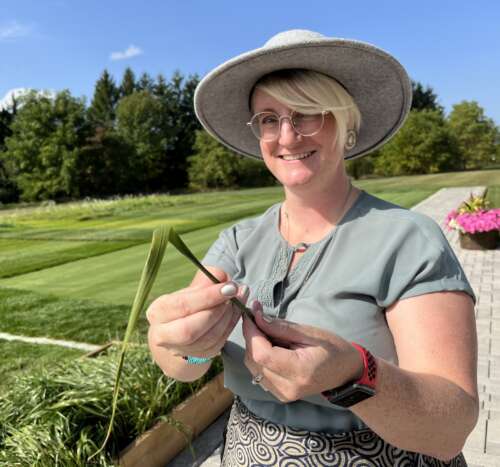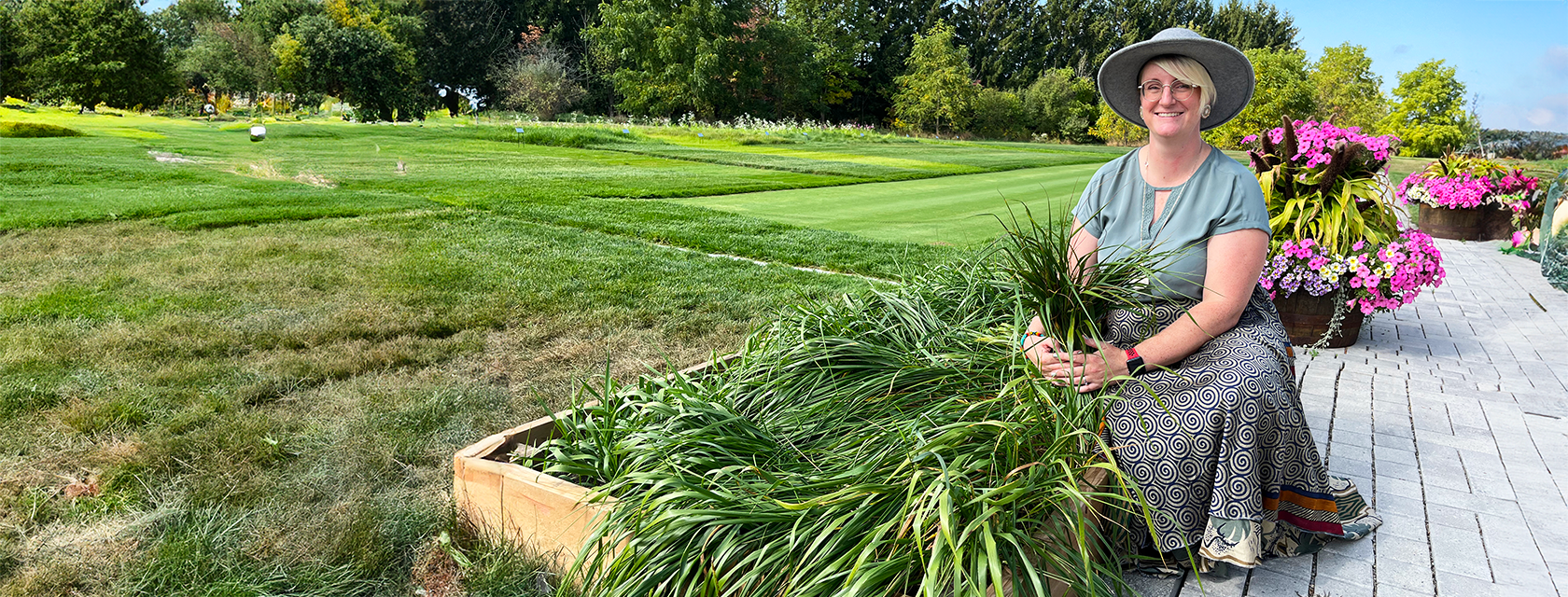It was reading Robin Wall Kimmerer’s Braiding Sweetgrass that prompted Dr. Sara Stricker to think about how to incorporate the aromatic plant into her work at the Guelph Turfgrass Institute (GTI).
In her role as the communications and outreach coordinator at GTI, a research and education centre for turfgrass science, Stricker knows the value of connection and is always looking for new pathways to broaden GTI’s work.
As a non-Indigenous person with a desire to grow sweetgrass, such an initiative would require collaboration and a respectful approach. Stricker connected with Dr. Susan Chiblow, professor in the School of Environmental Sciences and Natasha Young, manager of the Indigenous Student Centre (ISC) as well as Elders Mary Lou and Dan Smoke to begin.
“You need to know someone who has sweetgrass to get sweetgrass,” she explains. “You have to build relationships and trust and maintain those relationships.
To create an interpretive sign for the garden that describes sweetgrass and its history, Stricker reached out to U of G alum Brad Howie, of Manoomin Learning, who built similar signage for the Arboretum.
“This is an opportunity for reciprocal learning,” she says. “I’m here to build sincere connections.”
Sweetgrass a sacred medicine for Indigenous communities

Sacred to Indigenous communities, including Anishinaabe and Métis peoples, sweetgrass is considered the “hair of Mother Earth,” Kimmerer writes in her book. For centuries it has been used in basketry, ceremonial smudging, for incense or perfume and is considered one of four sacred medicines.
“Our teachings about wiingashk, sweetgrass in Anishinaabemowin, remind us that individual blades of grass are delicate but braided together they become stronger and more resilient,” says Dr. Cara Wehkamp, assistant vice-president, Indigenous Initiatives. “Wiingashk reminds us that together we can positively impact our own lives, our communities and all of creation.”
Sweetgrass rarely germinates from seed, but instead thrives from being transplanted, and likes to grow around water. Native to Ontario, Quebec and the Eastern provinces, sweetgrass is today often found on private property or in areas that might be unsafe to explore, Stricker says.
“Sweetgrass is wild,” she explains. “It is not a cultivated plant, it spreads through rhizomes, underground roots. It does spread on its own, and it likes very moist conditions, but as a grass, can also handle a lot of drought.”
GTI is now home to a small, raised bed of sweetgrass planted this spring, kept separate from the centre’s other grasses, so as to avoid any fertilizers.
The goal of the sweetgrass garden, built from offerings Stricker received, is to make it more accessible and in the long term, use it as a teaching resource. She imagines an entire field of sweetgrass where students and the ISC can participate in honourable harvesting and she has begun creating a hub on the GTI’s website with educational resources.
Reconciliation at U of G
Stricker’s project is supported by U of G’s Equity, Diversity, and Inclusion Enhancement Fund, a grant that supports the University’s commitment to transform through Indigenization and other EDI initiatives. Soil was donated by Greenhorizons Sod Farms in Cambridge.
While U of G’s commitment to Indigenization stretches across campus, “it can’t just be the role of Indigenous students and scholars,” Stricker says, adding, “reconciliation is about taking action.”
The project, she says, “has been a terrific opportunity because otherwise, people would not necessarily see a connection between the Guelph Turfgrass Institute and our Indigenous initiatives. But I think it is a great bridge for multidisciplinary connections at the University.”
Wehkamp says the sweetgrass garden at the GTI is, “a wonderful addition to the campus community for both the educational aspects and as a source of connection for Indigenous students, staff and faculty.
“It embodies reconciliation through relationship building, sharing and ongoing collaboration and support.”
Contact:
Dr. Sara Stricker
gti@uoguelph.ca
